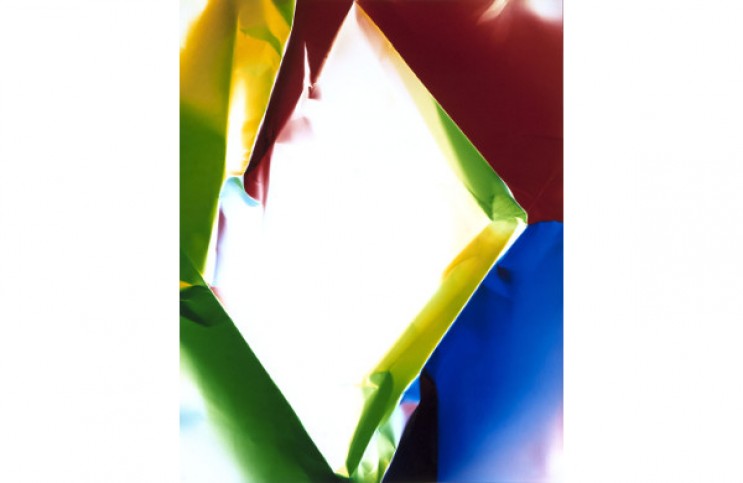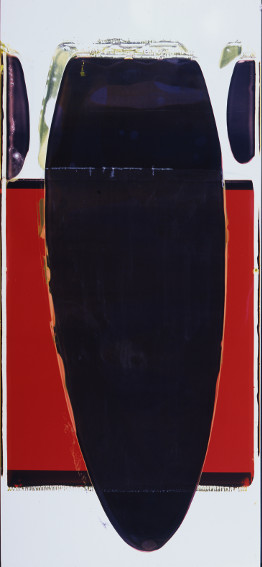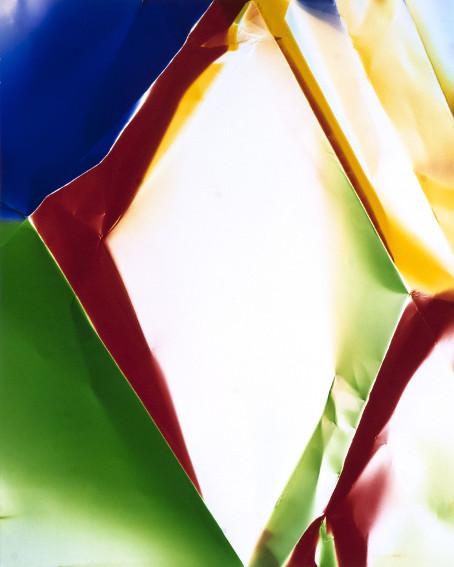
Ellen Carey and The World of Color in Photography
An exhibition of new work by Ellen Carey, titled Ellen Carey: Mirrors of Chance, opens at Galerie Miranda in Paris this month. The show introduces a new body of work by Carey called “Zerograms.” For several decades, Carey has been one of the leading experimental photographers of the American avant-garde. She coined the term “Photography Degree Zero” in 1996 for a body of work she felt marked a new beginning point for the photographic arts. The term relates directly back to the book “Writing Degree Zero” (1953) by Roland Barthes, which likewise established a new beginning point for avant-garde French literature. To arrive at “Photography Degree Zero,” Carey reimagined the inner workings of her familiar camera—a large format Polaroid. Rejecting it as a tool to take representative images of the real world, she instead imagined how it might be used to simply express color and light. Two bodies of work emerged from her experiments: Pulls and Rollbacks, names which reference the methods of their creation. Yet truthfully, her Pulls and Rollbacks did not mark the beginning of her search for abstraction. In 1992, four years prior, Carey had begun making abstract photograms—an ongoing series of work she calls “Struck By Light.” Photograms are the oldest types of photographic images. They emerge from a simple, natural process, wherein light and shadow collaborate to burn an image onto a surface. The works in the “Struck By Light” series are made entirely in the dark. Carey manipulates photosensitive materials without seeing what she is doing, using only her instincts. At the moment she exposes the work to light, the image is fixed. The vibrant colors and abstract shapes she coaxes into existence while in the dark are stunning to behold. They leave viewers entranced, delightfully unsure what they are looking at, or what the subject of the pictures might be.
Seizing Chances
The subtitle of Ellen Carey: Mirrors of Chance is a reference to the aforementioned method Carey uses to make the images in her “Struck By Light” series. Every form, every line, every color, and every shadow that she manifests is a direct reflection of an informed risk Casey took in the darkroom. The word chance, as in a game of chance, also celebrates the inherent possibility of failure that always follows Carey into her process. She might make all of the right plans ahead of time, and in the dark manage to follow through on all of her decisions, but the tools and processes still might rebel, altering her vision to suit their own nature. In that space between chance and choice is where the world of abstract potentiality opens up. There, Carey is like a jazz musician—an improvisational performer working within a framework, but who must be open to the beauty and meaning of the surprises that occur along the way.

Ellen Carey - Pull with Filigree, 2004. 203 x 55cm. © Ellen Carey and Galerie Miranda
In addition to her “Struck By Light” series, Galerie Miranda is also exhibiting a handful of large-scale “Pulls” and “Rollbacks.” This was a good curatorial decision. It demonstrates the true nature of Carey as an artist. The myriad differences and unexpected moments in these works reminds me of other innovative moments in the history of abstract art. They recall the excitement Helen Frankenthaler expressed when she first began making “soak-stain” paintings, pouring paint onto un-primed canvas on the floor, only partially knowing what to expect. They also strangely bring to mind the patterns and forms that emerged when Kazuo Shiraga, of the Gutai Group, performed “Challenge to the Mud” (1955). These artists knew the feel of their materials, and the limitations of their own bodies. But they could not anticipate the precise results of their artistic actions, nor precisely what physical relic might emerge from them. Her willingness to engage with an aesthetic position that leaves the end result up to unknown factors—her complete embrace of chance—makes Carey embody the spirit of these artists.

Ellen Carey - Pull with Red Rollback, 2006. © Ellen Carey and Galerie Miranda
Introducing the Zerogram
Another high point of Ellen Carey: Mirrors of Chance is that this exhibition publicly debuts a brand new series of works that Carey has recently been developing. She calls these works “Zerograms.” They take their name from the idea that represent a marriage of the methods Carey employs for her two other major series. The “zero” part is there because the works in the “Photography Degree Zero” series came about as the result of Carey moving beyond her mastery of an established photographic technique. She mastered the large-format Polaroid, then reinventing what the tools and techniques could be used for. Similarly, now that she has mastered the techniques used in her “Struck By Light” photogram series, Carey has reinvented her darkroom processes. “Zerograms” are the result. They blend the essential aspects of her two previous series in an attempt to discover what a new breed of abstract photogram for the 21st Century might look like.

Ellen Carey - Zerogram, 2018. © Ellen Carey and Galerie Miranda
The first reaction I had to the “Zerograms” is that they exude a sense of control. The stark, geometric void in their center calls my eye inward, not like I am looking at something empty, but rather like I am being pulled towards something unseen. The shadows and colors, however, confidently hold their own. Unlike in a Rothko painting, which draws me inward towards myself, the fields of color on these “Zerograms” draw me in towards them. The mastery of technique Carey displays with these new works is especially evident in their depth of field, where color, shadow, and void meld together in ethereal layers. Her materials seem to transcend their own physical qualities, allowing these pictures to become something more than pictures. Whether I would call them a new zero point, I am not ready to say. But they are undeniably challenging both to my eye, and to my mind. Ellen Carey: Mirrors of Chance is on view at Galerie Miranda in Paris from 7 September through 20 October 2018.
Featured image: Ellen Carey - Zerogram, 2018. © Ellen Carey and Galerie Miranda
By Phillip Barcio






